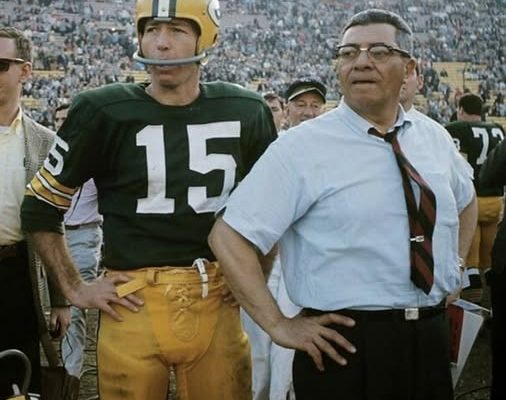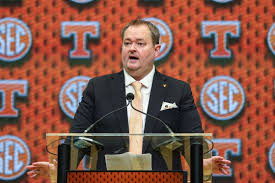It was more than just a photograph. It was a moment etched in time—two men standing side by side at the Los Angeles Memorial Coliseum in 1967, their shadows cast by a fading sun and their legacy about to be sealed in football immortality. Bart Starr and Vince Lombardi, the quarterback and the coach, were not merely posing for the camera—they were symbols of what the NFL would soon become. In that singular instant, greatness met greatness. And together, they stood at the brink of something new—the Super Bowl era. This image has transcended decades, not because of its aesthetic, but because of what it represented: leadership, discipline, unity, and a commitment to excellence that reshaped the Green Bay Packers and, ultimately, the sport of professional football.
Bart Starr, the unassuming quarterback from Montgomery, Alabama, embodied calm, calculation, and composure. He wasn’t brash. He didn’t seek the spotlight. He wasn’t physically imposing or the fastest runner on the field. But Starr had something rarer than raw athleticism—he had poise, intelligence, and a remarkable ability to execute under pressure. He was the perfect general for Vince Lombardi’s army. Lombardi, in stark contrast, was intense, loud, driven by faith and fire. He had come to Green Bay in 1959, a city long buried in the bottom rungs of the NFL, and he had one goal in mind: to win. He brought with him a philosophy that fused mental toughness with moral clarity. “Winning isn’t everything,” he once famously said, “it’s the only thing.” That attitude didn’t just change the Packers—it changed football itself.
The bond between coach and quarterback was built not on similarity but on complementarity. Lombardi’s fire found its perfect balance in Starr’s ice. Where Lombardi barked and demanded, Starr listened and delivered. They respected each other deeply, but that respect was hard-earned. Lombardi didn’t hand Starr the keys to the offense right away. In fact, it took time for Starr to win the coach’s trust. But when he did, their relationship flourished into one of the most effective and symbiotic in NFL history. Starr became the extension of Lombardi on the field, executing the famed “Packers Sweep” with machine-like precision. That play—the brainchild of Lombardi—became the signature of a dynasty. The guards would pull, the backs would follow, and Starr would read the defense like a chess master plotting three moves ahead. It wasn’t flashy, but it was brutal, consistent, and unstoppable when run correctly.
By the time 1967 arrived, the Lombardi-Starr Packers had already established themselves as a powerhouse. Five NFL championships in seven years, dominance on both sides of the ball, and a reputation for discipline that intimidated opponents before the first whistle even blew. Yet something new loomed on the horizon—the AFL-NFL World Championship Game, later known simply as the Super Bowl. The inaugural contest in January 1967 would pit the champion of the old guard, the NFL, against the brash, upstart champion of the AFL. The Packers, representing the NFL, faced the Kansas City Chiefs. Critics questioned whether the two leagues were truly equal. Lombardi and Starr made sure there was no doubt.
Super Bowl I wasn’t the spectacle we know today. It wasn’t even sold out. But for the Packers, it was a mission. Starr’s efficient performance—16 of 23 passes for 250 yards and two touchdowns—earned him the game’s first MVP award. Lombardi’s meticulous preparation ensured that the Packers were ready for every wrinkle the Chiefs tried. Green Bay rolled to a 35-10 victory. It was a statement. The NFL was superior. The Packers were supreme. And the coach-quarterback duo that had orchestrated it all walked off the field having changed the course of football history.
A year later, they would do it again, this time in Super Bowl II against the Oakland Raiders. Another decisive victory. Another MVP performance for Starr. Another display of tactical brilliance from Lombardi. But by then, it was also the end of an era. Lombardi would soon retire from coaching in Green Bay, passing the torch but never the values. Starr would play several more seasons, but the peak had been reached. What remained was the legacy—one forged in practice fields, locker room speeches, silent huddles, and moments like the one captured in that 1967 Coliseum photo.
That image isn’t just about football. It’s about leadership. It’s about what happens when two people, with different temperaments but shared purpose, commit fully to a cause larger than themselves. Lombardi didn’t just teach plays—he taught responsibility, commitment, and pride. Starr didn’t just throw touchdowns—he embodied consistency, patience, and humility. Their dynamic was rooted in mutual trust. Lombardi knew that when he called a play, Starr would execute it not only as drawn up, but with adjustments born from experience and instinct. Starr knew that his coach would never ask for less than his best, and that high standard became contagious within the locker room.
This foundation of trust and excellence became the model for successful franchises across the league. From Walsh and Montana in San Francisco to Belichick and Brady in New England, the shadow of Lombardi and Starr lingers. Every quarterback who leads with grace, every coach who demands accountability, walks in their footsteps. The Packers’ legacy is their blueprint—accountability, preparation, and respect for the game.
Even today, in a sport increasingly dominated by fast-paced offenses, social media presence, and player mobility, the image of Starr and Lombardi reminds us of something timeless. Greatness doesn’t come easy. It is not the product of luck or talent alone. It is forged—through repetition, belief, and shared values. In Green Bay, where the weather is cold but the fans are loyal, that legacy lives on in every game played at Lambeau Field.
And it wasn’t just about football. Lombardi broke barriers. He demanded respect across racial lines, insisting on equality and dignity for every player on his team. He was fiercely loyal to his men, and in return, they played their hearts out for him. Starr, in turn, led not with ego, but with character. He was known for his quiet leadership, his ability to lift teammates with encouragement rather than criticism, and his steadfastness in the face of adversity. Off the field, he carried himself with dignity and humility, traits that made him beloved long after his playing days were over.
The 1967 photograph is a window into that golden era. In it, you see Starr’s quiet confidence, Lombardi’s intense focus, and the unspoken bond between them. It’s more than a picture; it’s a reminder of how standards were set and how legacies were born. This was before the television deals ballooned, before the draft became a national event, before touchdowns were celebrated with choreographed dances. It was just football, pure and proud. And at its pinnacle stood two men, united in vision.
When Vince Lombardi passed away in 1970, the NFL renamed its championship trophy in his honor. Every Super Bowl winner hoists the Lombardi Trophy not just as champions of a game, but as inheritors of a tradition. And when that trophy is raised, somewhere in the minds of football fans everywhere is the image of Bart Starr—calm in the pocket, commanding the huddle, executing the sweep—and Lombardi on the sidelines, clipboard in hand, watching his masterpiece unfold. That legacy, like the photograph, is forever.
For the Packers faithful, that image captured in Los Angeles is not simply nostalgia—it’s a reminder of who they are. A small-town team that reached the summit. A team that proved preparation, unity, and discipline could overcome size, flash, and flair. A team that still plays on the “frozen tundra” of Lambeau Field, where echoes of Lombardi’s commands still seem to ride the wind and Starr’s precision seems to pulse through the turf.
In that still frame from 1967, you don’t just see a coach and a quarterback. You see the soul of a franchise. You see what happens when greatness is pursued with humility, when leadership is earned, not assumed, and when the game is played the right way. You see history—not in black and white, but in the green and gold glow of something enduring.
Frozen in glory, yes. But never frozen in time. That legacy still breathes. It walks the sidelines, echoes in pregame speeches, and lives in the dreams of every young quarterback who wants to lead with grace and every coach who wants to inspire with passion. Lombardi and Starr weren’t just the best of their era—they were the best of what football can be.



